Metz hosted Lyon in this past Sunday’s late kick-off in Ligue 1, and the away side took all three points from this game as they came away with a 3-1 victory that keeps them inside of the UEFA Champions League qualification places and within touching distance of league leaders PSG, who sit just two points ahead of Lyon in France’s top-flight at present.
Meanwhile, Sunday’s defeat leaves Metz sitting in 13th place on the league table and without a win in any of their last four Ligue 1 fixtures.
In this tactical analysis piece, we will examine the tactics that both of these sides utilised to try and outwit their opponent in Sunday’s Ligue 1 clash. We’ll provide some analysis of the key aspects of both team’s respective tactical set-ups from each phase of play, and we’ll try to determine how much of a significant role the tactics that they used influenced the outcome of the game – a Lyon victory.
Lineups and formations
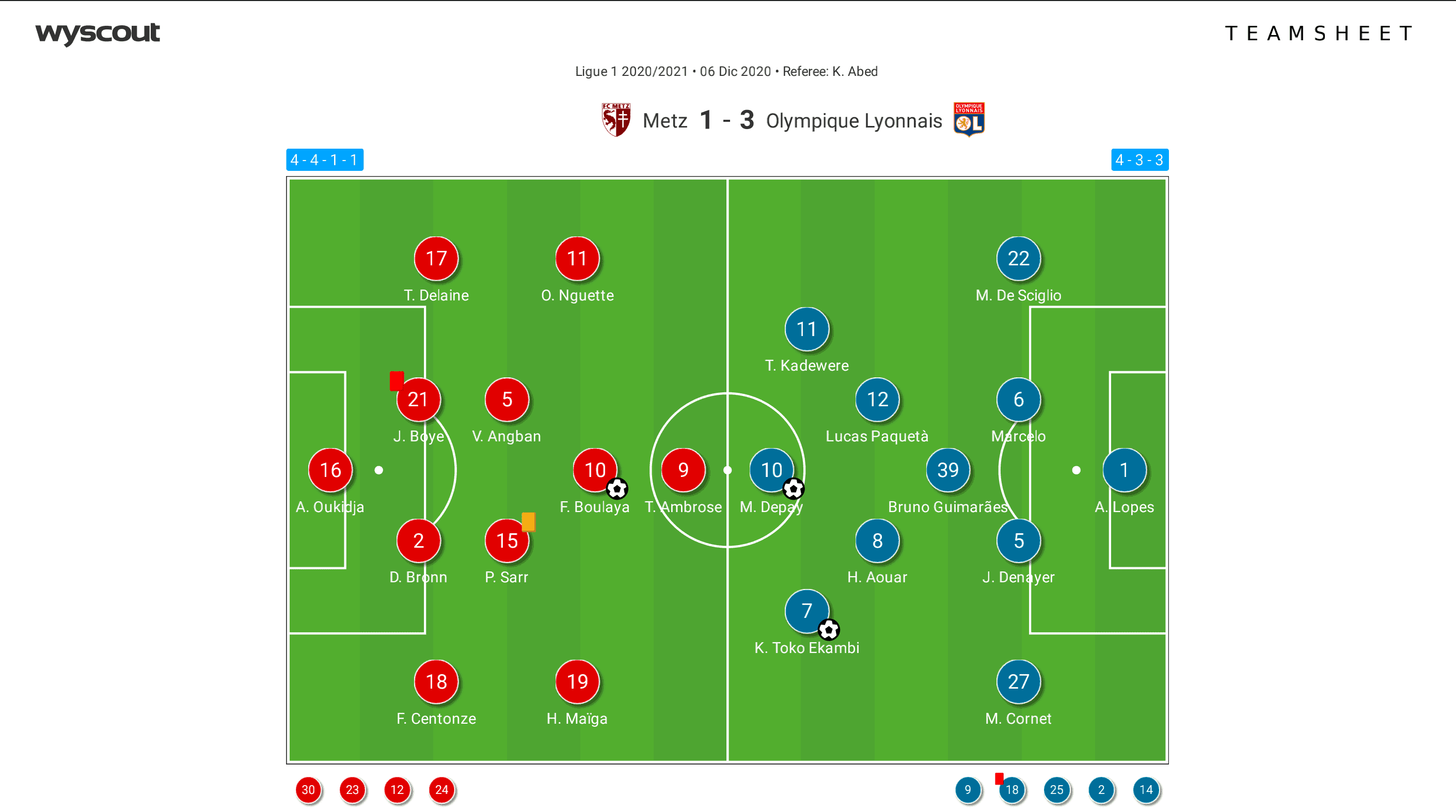
Firstly, we’ll take a look at how both of these teams lined up for this game, starting with the home side. Frédéric Antonetti lined his team up in a 4-4-1-1 shape for Sunday’s game.
Alexandre Oukidja started in goal for Les Grenats, while the back four in front of him consisted of right-back Fabien Centonze, left-back Thomas Delaine, right centre-back Dylan Bronn and left centre-back, John Boye.
In front of them, sat a midfield four made up of right midfielder Habib Maïga, left midfielder Ope Nguette, and the central midfield duo of Victorien Angban on the left and Pape Matar Sarr on the right. Farid Boulaya played just in front of them in the ‘number 10’ position, just behind centre-forward Thierry Ambrose.
At half-time, Aaron Leya Iseka replaced Ambrose upfront, and Warren Tchimbembé replaced Sarr in central midfield. At the 63rd minute, Metz made their third change of the contest when Boubakar Kouyaté replaced Angban, and Les Grenats were forced into a fourth and final change in second-half stoppage time when Marc-Auréle Caillard replaced injured Oukidja between the sticks to see out the game.
As for the away side, Rudi Garcia lined his men up in a 4-3-3 shape on Sunday, which became a 4-1-4-1 off the ball, with Anthony Lopes starting in goal for Les Gones, behind a back four of right-back Mattia De Sciglio, left-back Maxwel Cornet, right centre-back Marcelo and left centre-back Jason Denayer.
Bruno Guimarães played at the base of Lyon’s midfield, behind the central midfield duo of Houssem Aouar on the left and Lucas Paquetá on the right, while Tino Kadewere played on the right-wing, Karl Toko-Ekambi played on the left-wing, and Memphis Depay occupied the centre-forward position, though this front three was fluid, with all three men comfortable with playing out wide or in the centre, and with Depay comfortable with dropping deep to create space centrally for either/both of the wide men to move into which they did at times.
Garcia used five substitutes in this game. Firstly, Moussa Dembélé replaced Kadewere in the 63rd minute and just a minute after that changed was made, Maxence Caqueret replaced Aouar, and Léo Dubois came on for De Sciglio. Later on, in the 79th minute, Rayan Cherki took Depay’s place upfront and lastly, in the 82nd minute, Sinaly Diomandé came on for Guimarães, shoring up the Lyon defence for the final portion of the contest.
Metz’s tactics off the ball
Next up, we’re going to provide some analysis of the tactics that Metz used without the ball in Sunday’s fixture at Stade Saint-Symphorien. In this section of the analysis, we’ll examine the home side’s shape without the ball, as well as some of the key elements to their defensive tactics while defending deep inside of their half and in more advanced areas of the pitch versus Lyon.
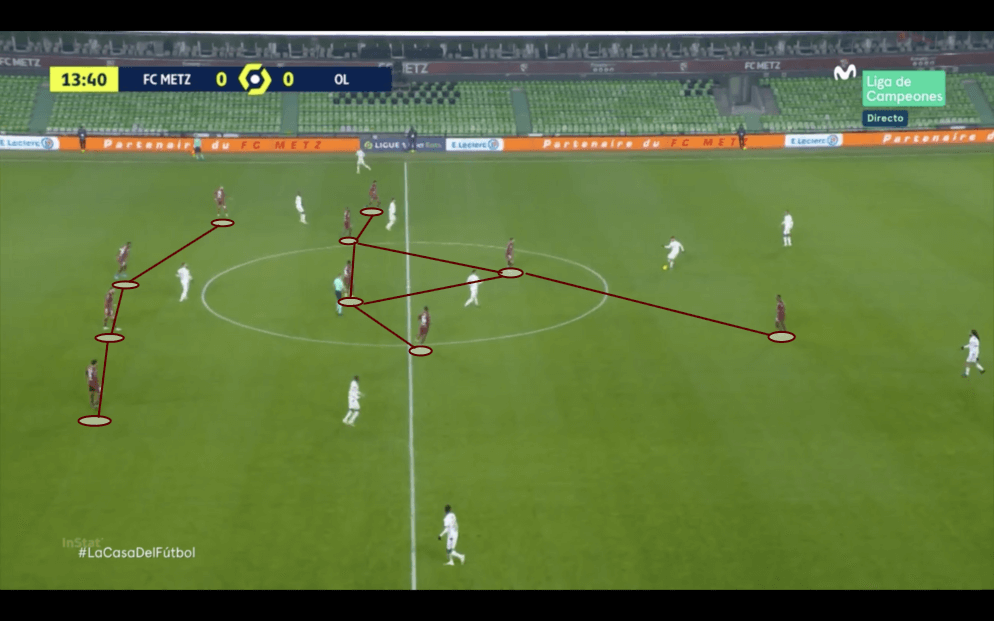
Firstly, the image above provides us with a general view of how Metz shaped up without the ball versus Les Gones. We can see their 4-4-1-1 shape in practice here, and one of the most notable things about Les Grenats’ shape during this game was how narrow they were without the ball.
Metz’s full-backs tended to sit very narrowly, maintaining a close distance between themselves and the centre-backs, while they also kept themselves close to Lyon’s inside forwards, Toko-Ekambi and Kadewere, who tended to drift inside to the half-spaces while their team was on the ball.
In addition to that, Metz’s wide midfielders acted similarly to the full-backs in that they maintained a close distance to the central midfielders and this helped Metz in their attempts to prevent Lyon from playing through the middle of the park, as the narrowly-positioned wide midfielders, as well as the ‘10,’ who also sat fairly deep at times, helped to create a central superiority for the home side and limit the space for the creative Lyon midfield trio to play within.
The striker, Ambrose in the first half and Iseka in the second was positioned higher, but they didn’t apply a great deal of pressure to Lyon’s backline when attempting to play out from the back and this allowed them enough time to play the ball out more often than not. Furthermore, Metz’s very narrow defensive shape naturally left a lot of space out wide, and with Les Gones playing with inside forwards who drifted into the half-spaces, occupying the Metz full-backs in the process, this created a lot of space for Lyon’s full-backs to exploit out wide which they did throughout the game, and this is where a lot of the away side’s ball-progression came from.
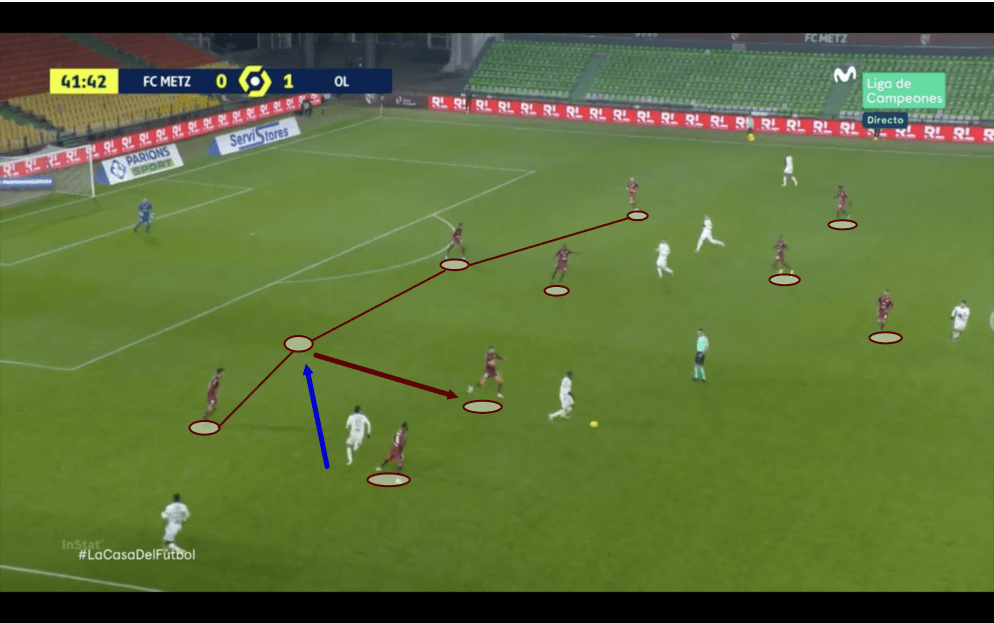
Here, we can see Metz defending in a slightly deeper area of the pitch, though we can still see them playing in their 4-4-1-1 shape, but with striker Ambrose out of shot just due to the camera angle which doesn’t capture him sitting higher up the pitch.
We can see here that Metz’s defensive shape has become slightly wider as Lyon have progressed into their half via the wings, which resulted in Metz’s shape becoming stretched as players were forced to shift out wide to some extent to apply some pressure to the Lyon attackers.
Additionally, we can also see that right centre-back Bronn has vacated his deeper position to chase down Toko-Ekambi, who’s received the ball from the wide man after dropping slightly off the Metz backline. To prevent him from enjoying too much space after dropping deep, this Metz centre-back follows him out of defence, essentially into central midfield, and this is how Metz’s centre-backs and full-backs acted in this game in their attempts to deal with the movement of Lyon’s front three.
Depay, Kadewere and Toko-Ekambi all liked to drop off the backline into deeper areas, pulling out the Metz defender nearest to them due to the aggressive way in which they defended against Lyon’s front three in the process and this created large gaps in Metz’s defence, like the one we can see one Lyon player attempting to exploit here, throughout this contest and Lyon managed to exploit these gaps on several occasions, as we’ll discuss later on in this tactical analysis piece, which may suggest that this wasn’t the best choice of defensive tactics from Antonetti for this one.
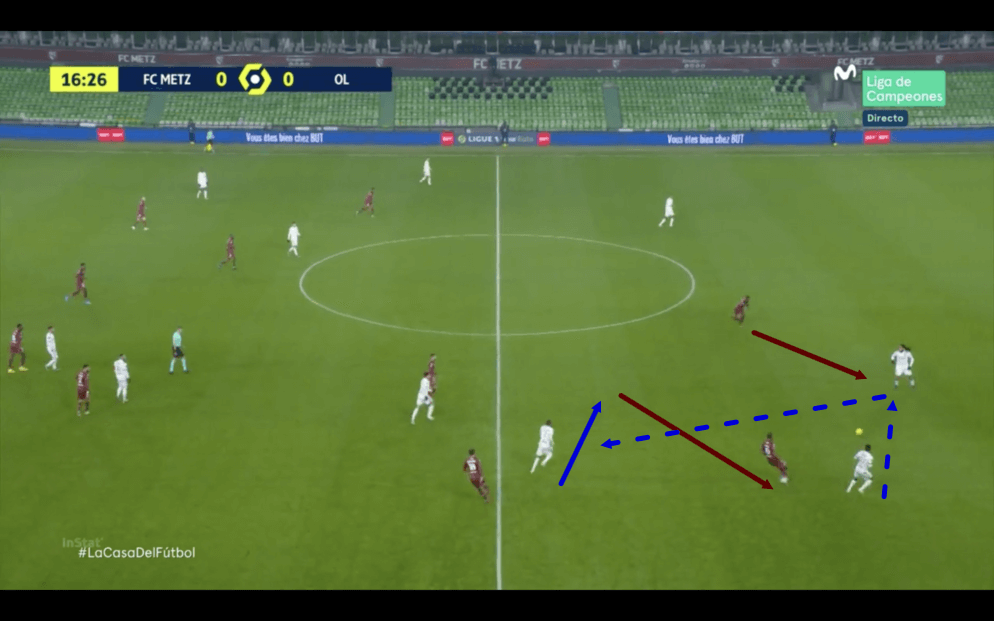
Lastly, Metz didn’t press very aggressively and generally set up to try and win the ball back in deeper areas of the pitch rather than more advanced areas of the pitch, but they did press to an extent on numerous occasions, but ineffectively more often than not.
When they did press Lyon more aggressively from the front, there was a distinct lack of intensity in their pressing, and it seemed all too easy for Les Gones to play past them. We can see an example of one such scenario in the image above. Here, we can see left-back Cornet playing the ball to left centre=back Denayer, as the passing lane to Toko-Ekambi is blocked off by Metz’s ‘number 10’.
Then, as Denayer receives the ball, Ambrose closes in on him; however, Toko-Ekambi drifts inside to make himself available for Denayer, and the ‘10’ doesn’t follow him, as that would leave the pass back to Cornet open, while the right midfielder doesn’t follow him either as he sticks more tightly to his zone. This allows the wide man to receive the ball and help his side to continue this manoeuvre which ultimately leads to Lyon playing out past Metz’s defensive set-up.
So, as we can see in this example, while Metz’s attackers and midfielders did press Lyon high on occasion to an extent during this game, the solution to their pressure was far too easy for Les Gones to find the vast majority of the time and their pressing rarely led to turnovers or much difficulty at all for Garcia’s men.
Lyon’s tactics off the ball
We’ll take a look at Lyon’s tactics off the ball in Sunday’s game in this next section of analysis. We’ll take a look at how Garcia’s side’s defensive tactics differed from Antonetti’s team’s defensive tactics in this particular section and, similarly to the previous section; we’ll look at how Lyon defended against Metz in different areas of the pitch during this Ligue 1 fixture.
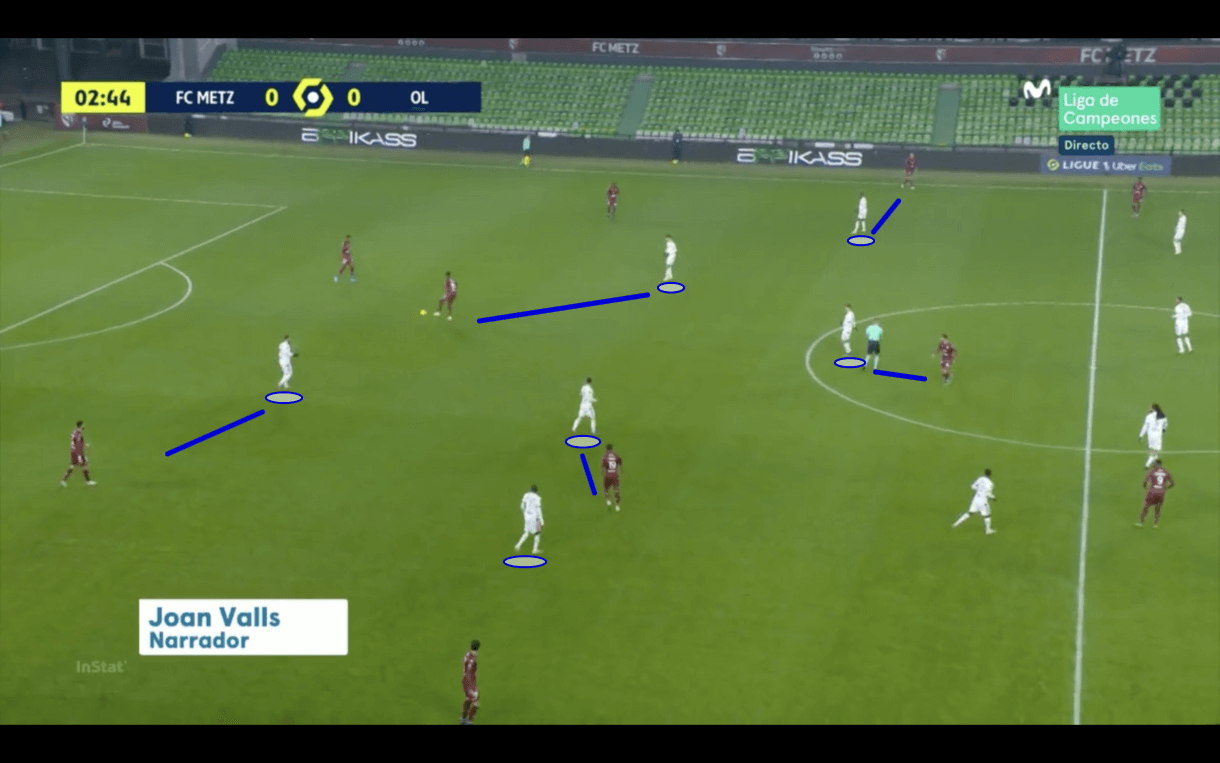
Firstly, Lyon’s tactics without the ball differed significantly from Metz’s tactics without the ball in that Garcia’s side pressed with far more intensity and with far more success in terms of forcing turnovers high up the pitch.
This image above shows us an example of Lyon’s 4-1-4-1 shape from Sunday’s game. They defended in a zonal marking system which didn’t see their players get dragged about very much due to the movement of Metz’s players, though Guimarães, in particular, did stick tight to the opposition’s ‘number 10’ at times. However, the rest of Lyon’s midfield and centre-forward Depay were quite disciplined in sticking to their respective zones, which we can see an example of here, where we can see Metz’s left central midfielder receiving the ball in some space after drifting into a deep, central position, a decent distance away from all nearby markers.
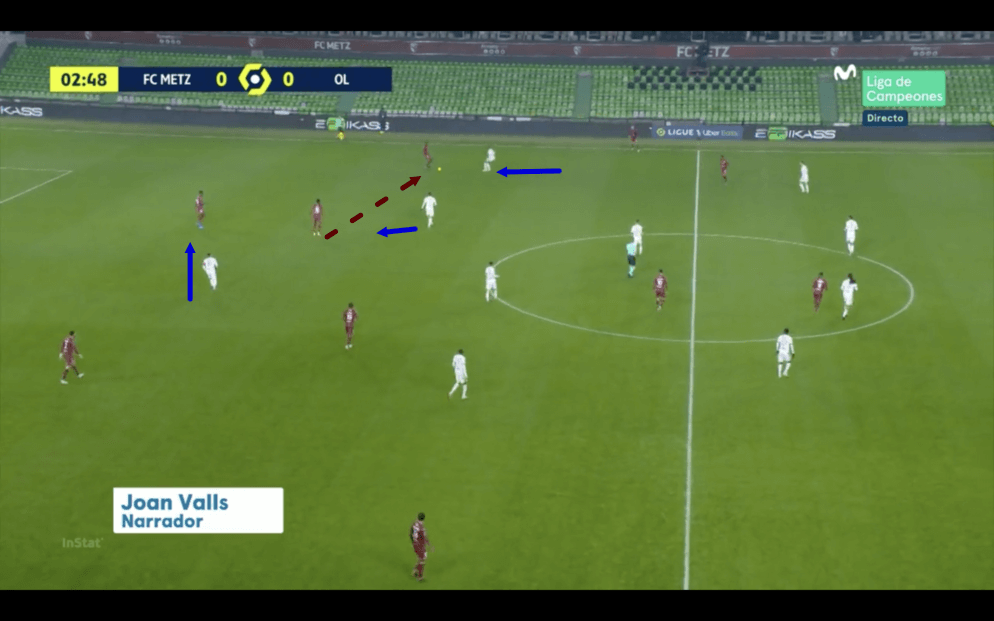
As Angban collected the ball, turned and then played it out wide to the left-back, however, this triggered Lyon’s press to move up a gear, as this pass resulted in Lyon’s right-winger Kadewere springing into action and closing down the left-back, while right central midfielder Paquetá then pushed up onto Angban to prevent the left-back from playing the ball back to him and Depay shifted over to the left centre-back to perform a similar role.
As the left-back’s simple, near passing options, were all essentially cut off here the left-back attempted to beat Kadewere, and the winger dispossessed him, winning the ball back high up the pitch for his side and kickstarting a Lyon counter-attack.
This provides us with just one example of Lyon’s defensive tactics in advanced areas of the pitch from Sunday’s game and how effective they could be for Les Gones.
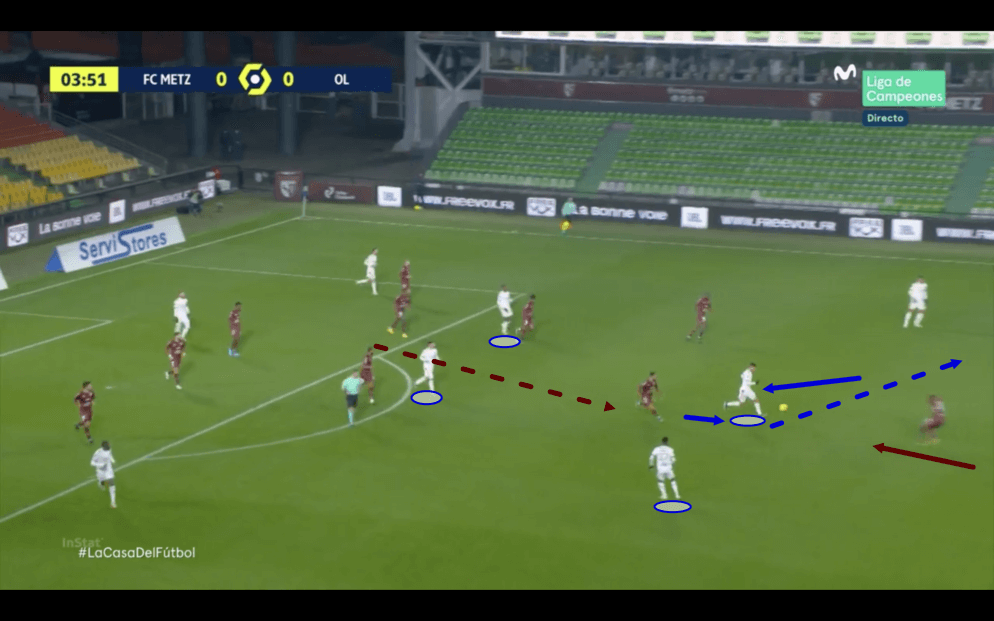
To highlight another element of Lyon’s aggressive defending from Sunday’s fixture, they counter-pressed Metz aggressively throughout the first half of this game, though this particular tactic became less prominent in the second half as Les Gones’ lead increased and they began to focus more on soaking up the pressure as Metz committed more men forward and then hitting the home side on the counter-attack from deep.
However, particularly in the first half, Lyon’s counter-pressing was effective in creating chances for them as they shut Metz down in the early stages of transition and created a counter-attacking situation for themselves high up the pitch.
We can see one example of this in the image above, where Paquetá can be seen on the ball just after Metz had cleared it away from the penalty box and out to ‘number 10’ Boulaya on the edge of the box, however, as he attempted to control the ball, Paquetá was right on top of him and he swiftly won the ball back for his side before Boulaya could link up with Ambrose who was dropping deep to offer some support to his teammate.
Paquetá then played the ball back to a slightly deeper teammate who could then play the ball forward and help Lyon to keep the pressure on Metz. Lyon’s central midfielders, Paquetá and Aouar, played a particularly significant role in this element of Les Gones’ game, as they tended to stay close to Metz’s players just outside of the penalty area like this so that they could close them down if the ball did fall to them before they could set their side off on the counter.
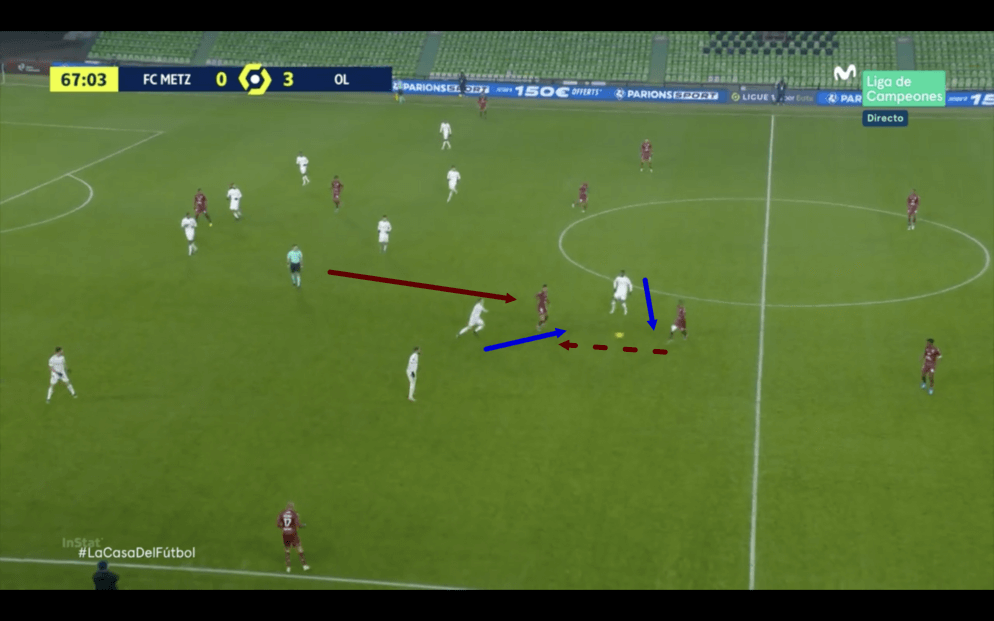
As explained previously, in the second half of the game, Lyon spent more time defending in deeper areas of the pitch, as their lead grew and Metz became more aggressive in how they attacked. Metz’s central midfield duo could enjoy more time on the ball inside of Lyon’s half as a result of this but this also naturally led to more Lyon bodies being positioned just in front of the penalty area, restricting the amount of space that Metz had to play in front of the box and particularly restricting the space that Metz’s ‘10’ Boulaya had to play in.
Boulaya ended up roaming around the opposition half as a result in search of the ball, and one of Lyon’s central midfield trio would typically pick him up depending on which player’s zone he entered at a particular time. In the image above, we can see that he’s dropped deep on the left side of central midfield to try and pick the ball up from the central midfielder, but as the pass is played to him, Paquetá springs into action, closing him down and intercepting the ball.
So, this shows us how Lyon’s defensive set-up made it difficult for Metz to find Boulaya, and other players in these positions, particularly when spending more time defending deep in the second half of the contest. Lyon won the ball back on numerous occasions from these positions, and as they did so, they set off on dangerous counter-attacks and put the pace in their attack to good use, troubling Metz’s defence by quickly creating overloads with the home side having committed plenty of numbers at the other end of the pitch.
Metz’s tactics on the ball
Now, we’ll move on to looking at how these teams played with the ball in Sunday’s game, starting with the home side. In this section of the analysis, we’ll look at some of the key aspects to Metz’s offensive tactics from this fixture, and we’ll take a look at why, in particular during the first half, many of their attacks broke down without a successful conclusion.
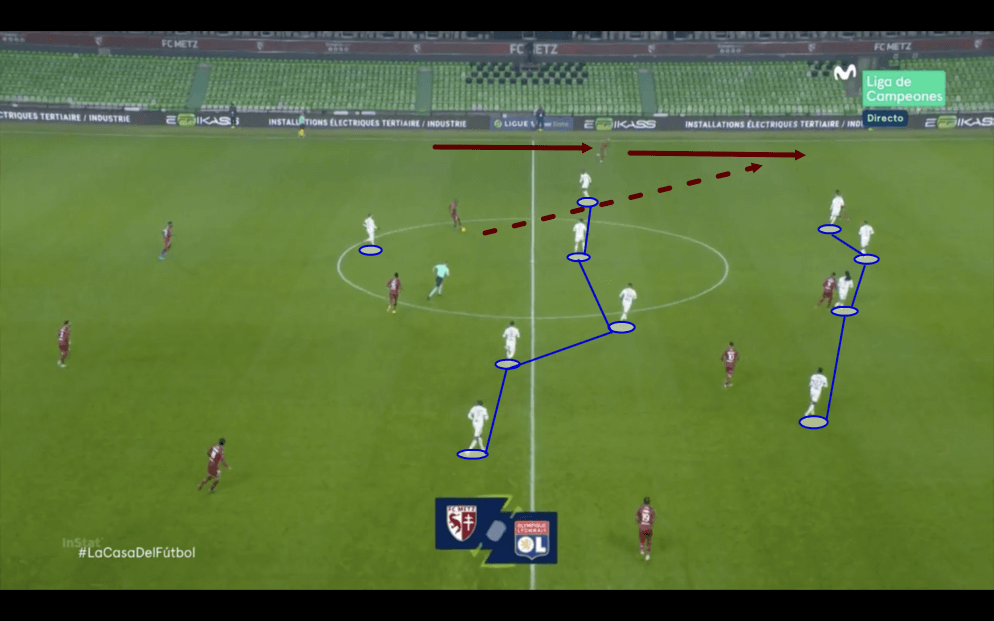
Firstly, this image above shows us that Lyon also defended fairly narrow at times and though not as narrow as Metz defended the majority of the time, their defensive shape was narrow enough for Metz to exploit the space out wide and to make this one of their main offensive outlets.
This space out wide, combined with the dribbling ability of Metz’s wide men, resulted in Metz making a noticeable effort to get their wingers in 1v1 situations against Lyon’s full-backs and when they did manage to successfully create these scenarios, they looked very dangerous, with left-winger Nguette even managing to win his side a penalty early on in the game after receiving the ball out wide via a crossfield ball, which attracted pressure from Lyon’s right-back De Sciglio, who Nguette was able to beat and this drew pressure from Marcelo who dived in and gave the home side a penalty which they failed to convert.
However, that scenario did prove how dangerous Metz’s wingers were, and they often had the better of Lyon’s full-backs during this game via their tricky dribbling ability, with Metz’s goal also coming as a result of Nguette taking the ball past multiple men on the wing before he provided the assist for Boulaya’s second-half strike but despite the fact that Metz were extremely dangerous when their wingers were put in 1v1 situations versus Lyon’s full-backs, they were ultimately unable to convert enough of the chances that were created as a result of their wingers’ dribbling quality.
Metz also attempted to create 2v1 overloads out wide with their overlapping full-backs providing support to their tricky wingers, and this too was effective on some occasions, even if the resulting crosses weren’t very productive, however, it’s important to note that Lyon took advantage of Metz’s full-backs’ willingness to get forward as they exploited the space that they left behind them out wide in their own half on the counter and Lyon particularly focused a lot of their second-half counter-attacks down the right-wing, where plenty of space was often left due to Metz’s right-back’s tendency to get forward.
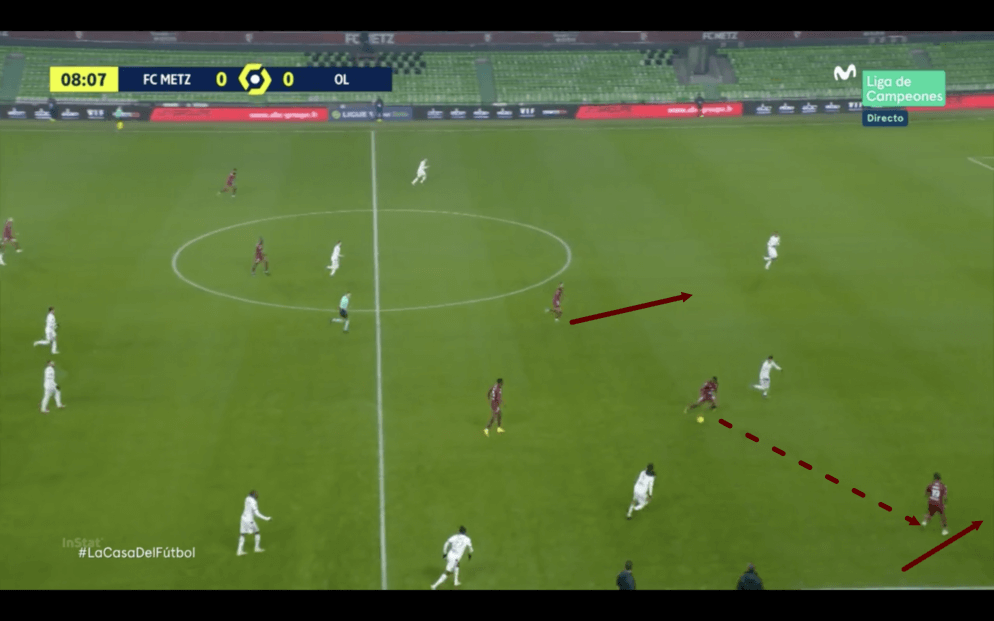
It didn’t come as a massive surprise that Ambrose was taken off at half-time by Metz, as he didn’t produce a very impressive first-half performance. He was largely ineffective as the focal point of the home side’s attacks in the first half, with many of Metz’s attacks either getting significantly damaged or just breaking down altogether when they reached the centre-forward.
One example of Ambrose having a negative influence on Metz’s attacks can be seen in the image above. Just prior to this image being taken, Metz actually managed to win the ball back high up the pitch thanks to the defensive work of right-winger Maïga, and after he won the ball back, he quickly played it into the feet of centre-forward Ambrose and continued his run down the wing.
As Ambrose received the ball, he took a little bit too long to get it under control and then played a pass that didn’t have a tonne of pace on it, resulting in this potentially dangerous counter-attacking situation, with Metz on the verge of overloading Lyon’s backline in this image above, losing a lot of its threat.
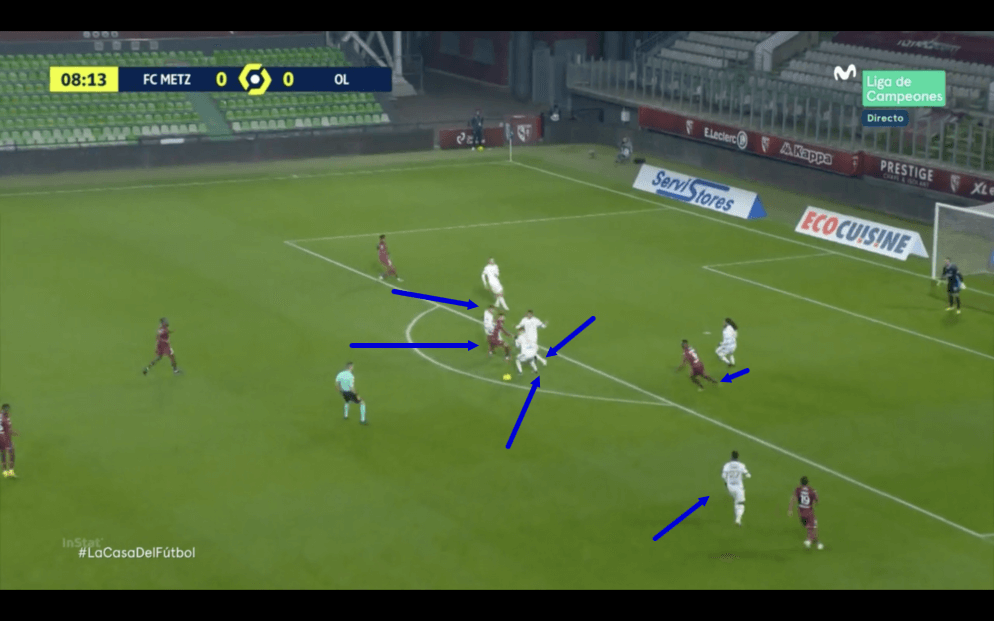
In the image above, we can see that as this passage of play moves on, Plenty of Lyon players were able to get back in time to prevent Metz from breaking past the defensive line, despite the fact that they had all but created a 3v2 situation just seconds earlier and Metz’s lack of urgency and intensity on the ball, particularly on the part of Ambrose here, could take plenty of the blame for that.
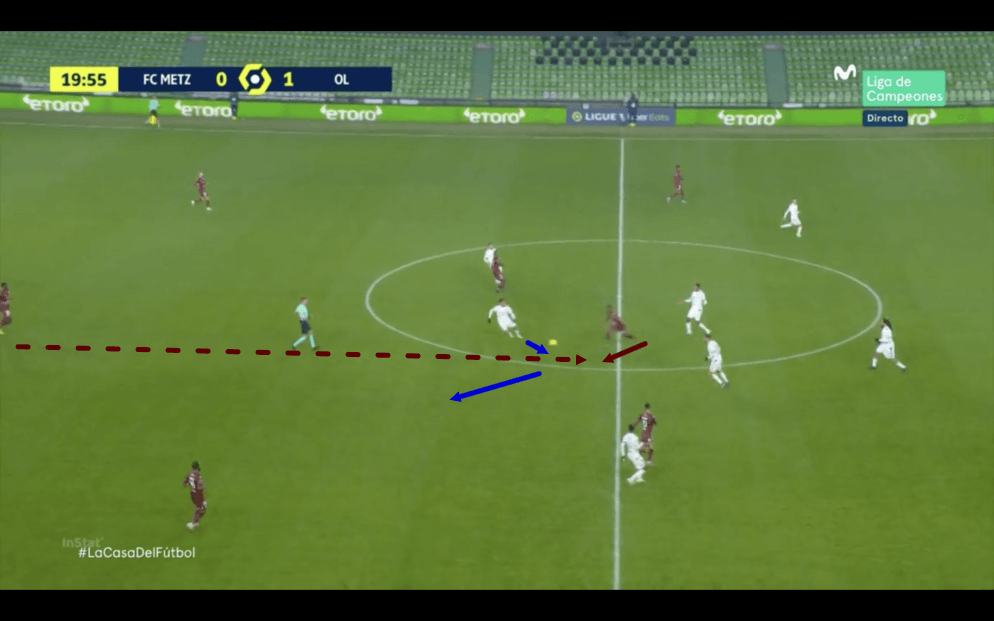
In this next image, we can see an example of an attack breaking down when the ball was played to Ambrose, as the centre-forward was unable to control the ball as Metz’s midfield played it directly to him as they looked to spring a counter-attack. Instead, his touch was too heavy, and Lyon could swiftly regain possession in central midfield and keep the pressure on Metz’s defence, showing that not only was Ambrose’s error detrimental to Metz’s attack but also to their defence.
On numerous occasions in the first half, the striker struggled with controlling the ball in situations like this where his side looked to him to hold the ball up as they attempted to start a counter-attack and this may be one of the big reasons for Metz’s lack of threat on the counter in the first half of this game.
Iseka was much better at controlling the ball and linking up with his teammates than Ambrose was when he replaced him for the second half, but his job also changed quite quickly, as Lyon began to sit deeper off the ball when they stretched their lead to two and then three goals early on in the second half, which led to Metz enjoying fewer counter-attacking situations and less space inside of the final third to play in.
It was definitely clear, however, that the centre-forward play of Ambrose did not help Metz’s chances of breaking down Lyon on the counter in this one on many occasions.
Lyon’s tactics on the ball
Lastly, we’ll take a close look at the away side’s game-winning tactics on the ball from Sunday’s game. Their counter-attacks that resulted from their patient defending and the use their pacey frontline were very effective in the second half, but in this section of the analysis, we’ll examine Lyon’s build-up play and the way in which they pulled apart Metz’s defensive shape to create chances when the home side was defending deep.
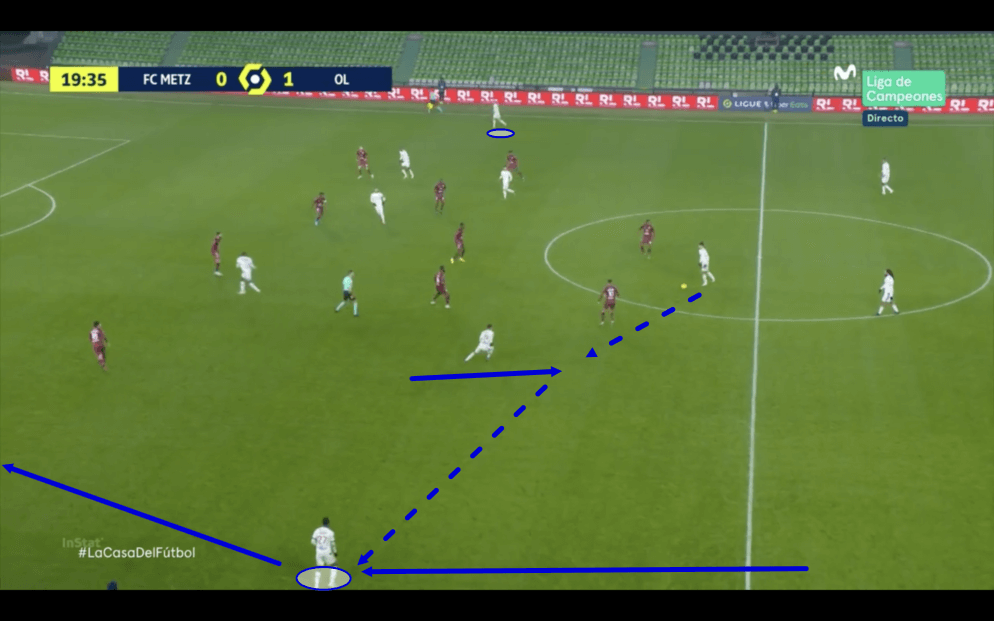
Firstly, as we mentioned previously, Metz defended in a very narrow 4-4-1-1 shape, and this left plenty of space out wide for Lyon’s full-backs to exploit, which they did, and we can see an example of Cornet pushing up to enjoy this space out wide in the image above.
As this passage of play moves on, Aouar drops deep to provide Guimarães with a short passing option, and the central midfielder then turns and relays the ball out to Cornet, with the winger-turned-full-back then carrying the ball upfield.
Lyon made use of this space out wide throughout the contest and frequently stretched Metz’s defensive shape by spreading the play out wide, while they also advanced the ball up the pitch frequently through this area due to the congested nature of central midfield, resulting from Metz’s narrow defensive shape.
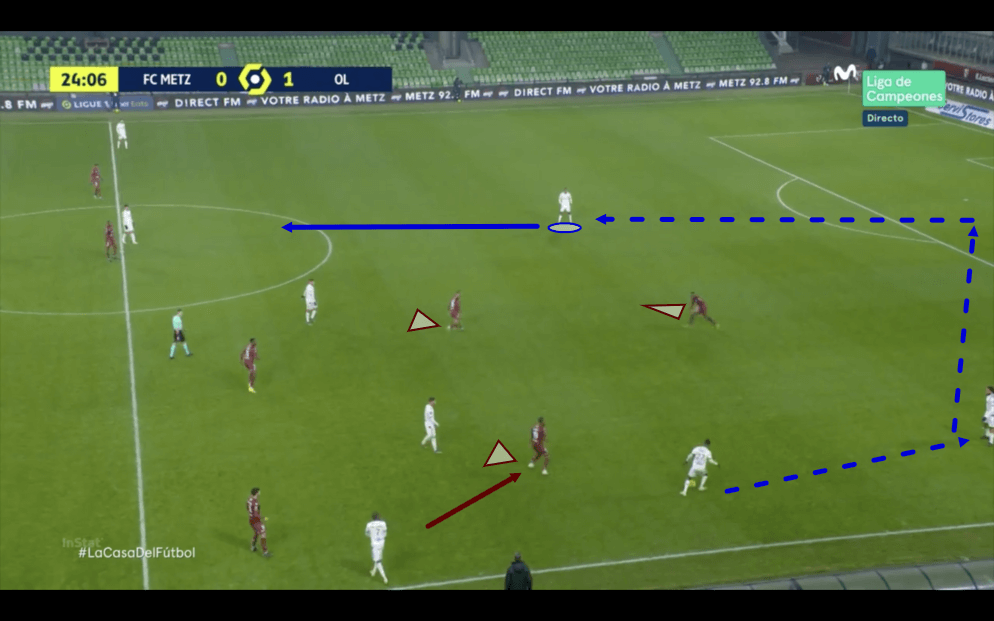
This next image shows us another example of Metz applying some pressure fairly high up the pitch, though, again in this situation, the home side didn’t apply enough pressure to force a turnover or really cause Lyon too much trouble to deal with the scenario swiftly and effectively.
We can see that Cornet’s passing lane to Aouar is blocked off, while Metz’s right-back has pushed up to get close to Toko-Ekambi on this particular occasion. Additionally, Boulaya is blocking off the pass into Guimarães and Ambrose can be seen blocking off the pass across goal to right centre-back Marcelo.
However, as the play moves on, Cornet opts to move backwards so that his team can quickly go forwards. He plays the ball to Denayer, who then goes all the way back to Lopes; however, this passing was quick, and as he receives the ball, Lopes relays it out to the other side of Ambrose to Marcelo, who can then carry the ball upfield and beat this bit of pressure for his side rather easily.
Lyon’s centre-backs made use of Lopes like this throughout Sunday’s game and played the ball to each other despite the centre-forwards presence in between them quite easily as a result, as neither Ambrose nor Iseka pressed Lyon’s backline very aggressively and this allowed Lyon all the time they needed to play past Metz’s press.
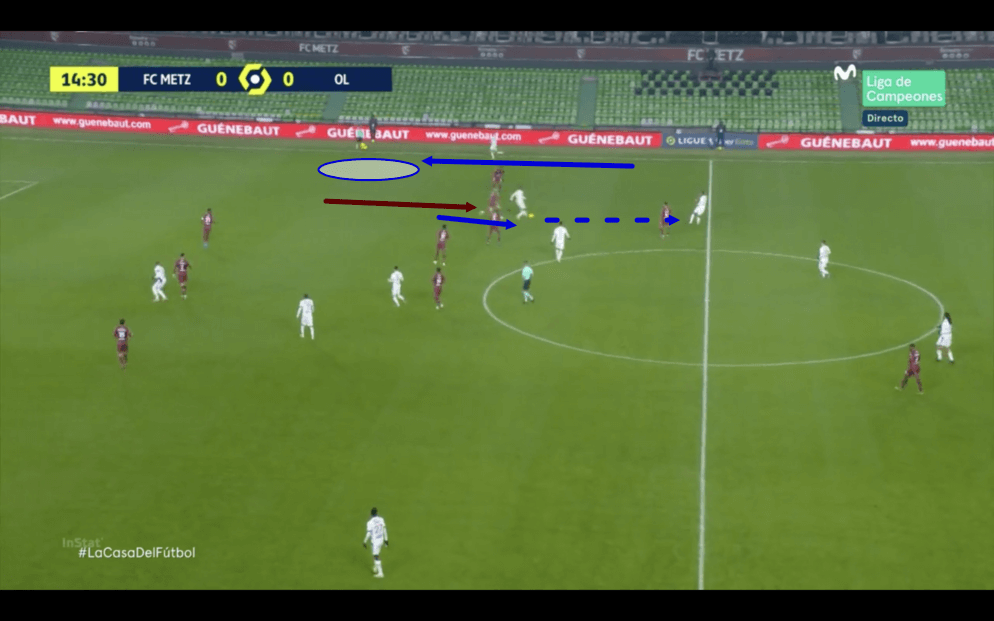
The movement of Lyon’s front three was particularly effective at creating trouble for Metz in this fixture. Firstly, the image above shows us how Depay dropped deep, pulling left-back Delaine out of the backline with him, and thus creating space for Lyon’s right-back to potentially probe into and exploit, as Depay plays the ball back to Marcelo after receiving the pass having dropped deep, with the right-back overlapping on the outside and with Metz’s left midfielder not dropping back far enough to prevent the right-back from being played in if the through ball comes his way.
This was an intelligent bit of movement from Depay and an intelligent move from Lyon overall, with Les Gones taking advantage of Metz’s backline’s tendency to stick tight to Lyon’s players as they dropped off from the defensive line, thus creating gaps.
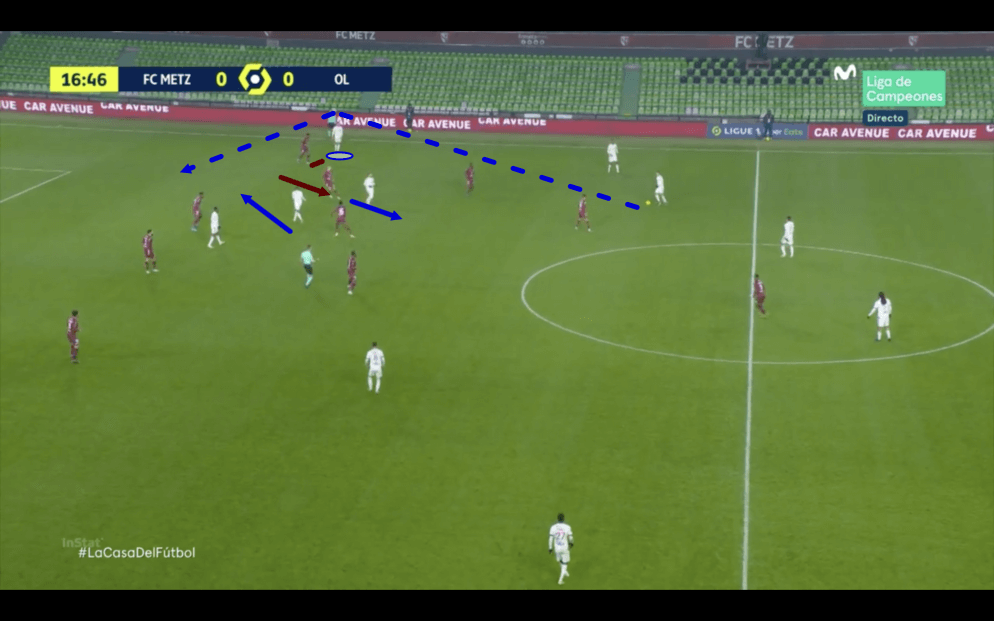
We can see another example of Depay dropping deep and dragging the left-back with him here, only on this occasion, he creates space for Toko-Ekanbi who is drifting out to the right into this space being created by Depay from the packed centre of the pitch.
As the forward moves into this area, the ball is played over the top of the defensive line, and Toko-Ekambi goes on to set-up Depay for the first goal of this game via this exact move, showing how impactful the movement of Lyon’s front three was for this fixture.
Conclusion
To conclude this tactical analysis piece, it’s clear that Metz’s counter-attacking wasn’t good enough in this game despite the impressive dribbling ability that was on display from their wingers.
Meanwhile, Lyon’s intelligent, well-organised defending, in addition to the impactful movement of their front three, played a significant role in helping Les Gones to take all three points from this one and it’s difficult to argue that they don’t deserve all the spoils from this one.





Comments